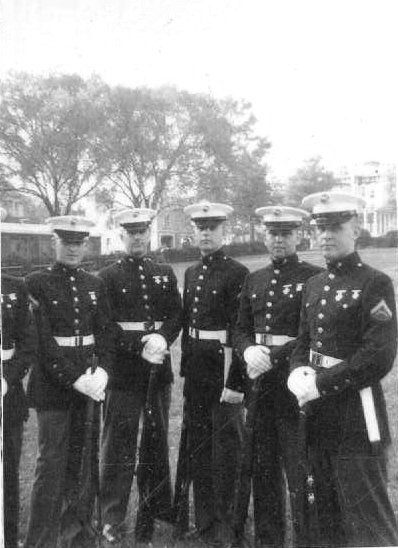 It was a long time between salutes.
It was a long time between salutes. On the opening night of Gulf War I, Spike sat parked at full throttle and exchanged the traditional "ready to launch" signal with his "yellow jacket."
Within a second the catapult he sat atop had thrown him off into the darkness... And for a brief moment the exhaust flame from Spike's Hornet became the brightest star on a moonless night.
Yesterday, August 13, 2009, TV cameras captured the precise slow-motion salute of six sailors in summer whites... It was held while family members approached the flag-draped coffin that held his remains on a runway in Jacksonville, Florida. And as they did, Jack explained Spike's dangerous mission of trying to disable radar-controlled Triple-A fire that enveloped the skies over al Anbar Province, how you could pull 9 Gs in evasive maneuvers trying to dodge SAMs, and the grief one felt at the loss of a shipmate.
 Jack himself was a ground-pounder, a retired Army colonel and Vietnam era recipient of the Medal of Honor.
Jack himself was a ground-pounder, a retired Army colonel and Vietnam era recipient of the Medal of Honor. Mark had been career Air Force. One of the most naturally cheerful people I ever met, he operated and maintained flight simulators for fighters, mostly Eagles. But the most difficult duty he faced during his 20 year enlistment was burial detail. Whether or not it ever involved pilots he knew, it left him unable to attend civilian funerals long after his last tour.
Ed felt he was more cop than soldier. His 15 years in the Coast Guard had been spent in shallow and domestic waters. An excellent gunsmith, he could make repairs on weapons at sea that would've sent most boats back to the docks for days. The injury that ended his time as a Guardsman also prevented him from going into the field as a police officer, but he sought out that connection by applying as a dispatcher.
Tony was an edgy character. The 28 dog tags he wore around his neck explained most of it.
As a recon Marine he was honor bound not to disclose the nature of his missions, or even the continent(s) on which he served. But each tag was removed by its owner prior to deployment, usually in two man sniper teams, always on assignments where discovering the U.S. identity of someone killed or captured would ruin the "plausible deniabilty" which provides cover for those who ordered a mission just as "gilly suits" camouflage those who execute it.
Given the levels of classification, Tony never knew whether a mission had succeeded or failed, only that members of his unit had never returned to reclaim their tags, and that the Corps had failed in respect to its own credo: "Leave no man behind."

Alan was supposed to "come home" as part of the wave of POWs led by John McCain. His Air Force F4C has been shot down over North Vietnam, too... October 18, 1965.
He arrived back in his hometown, and via a family friend I asked to interview him. Word came back that he wasn't himself yet, and a few days later he had taken his own life... His fragile grip on sanity loosened by his realization that what he thought at the time was part of the torture by his captors was true.
His brother Rob wrote: "His own countrymen went beyond being against the war; many supported those he understandably viewed to be the 'enemy.' This was not some philosophical or political concept for him. The enemy were the people who had beaten some of his comrades to death."
For decades his family maintained the young MIT aerospace student who entered the Air Force with dreams of becoming an astronaut had died "a victim not just of the North Vietnamese, but of the inability of so many in his own country, during that horrible war, to separate the war from the warriors." And by an act of Congress, Alan's name was added to the Wall.
Spike, Jack, Mark, Ed, Tony & Alan: Brothers in arms.

Of those who serve, not everyone makes it back alive, or at all.
Those who do are forever changed.

 Earthquake, tsunami,
Earthquake, tsunami,

No comments:
Post a Comment